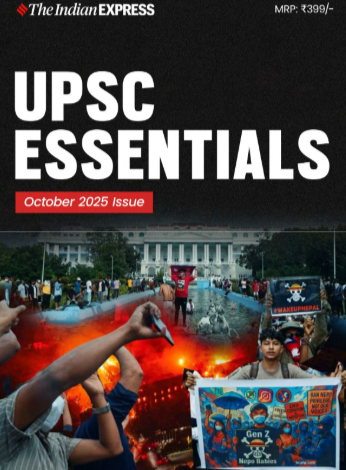Manas Srivastava leads the UPSC Essentials section of The Indian Express (digital). He majorly writes on UPSC, other competitive exams and education-related projects. In the past, Manas has represented India at the G-20 Youth Summit in Mexico. He is a former member of the Youth Council, GOI. A two-time topper/gold medallist in History (both in graduation and post-graduation) from Delhi University, he has mentored and taught UPSC aspirants for more than five years. His diverse role in The Indian Express consists of writing, editing, anchoring/ hosting, interviewing experts, and curating and simplifying news for the benefit of students. He hosts the YouTube talk show called ‘Art and Culture with Devdutt Pattanaik’ and a LIVE series on Instagram and YouTube called ‘LIVE with Manas’.His talks on ‘How to read a newspaper’ focus on newspaper reading as an essential habit for students. His articles and videos aim at finding solutions to the general queries of students and hence he believes in being students' editor, preparing them not just for any exam but helping them to become informed citizens. This is where he makes his teaching profession meet journalism. He is also the editor of UPSC Essentials' monthly magazine for the aspirants. He is a recipient of the Dip Chand Memorial Award, the Lala Ram Mohan Prize and Prof. Papiya Ghosh Memorial Prize for academic excellence. He was also awarded the University’s Post-Graduate Scholarship for pursuing M.A. in History where he chose to specialise in Ancient India due to his keen interest in Archaeology. He has also successfully completed a Certificate course on Women’s Studies by the Women’s Studies Development Centre, DU. As a part of N.S.S in the past, Manas has worked with national and international organisations and has shown keen interest and active participation in Social Service. He has led and been a part of projects involving areas such as gender sensitisation, persons with disability, helping slum dwellers, environment, adopting our heritage programme. He has also presented a case study on ‘Psychological stress among students’ at ICSQCC- Sri Lanka. As a compere for seminars and other events he likes to keep his orating hobby alive. His interests also lie in International Relations, Governance, Social issues, Essays and poetry. ... Read More
UPSC Weekly Quiz — April 2 to April 8, 2023
Brush up your knowledge on current events of the last week and consolidate your UPSC-CSE preparation. Find answers along with explanations at the end of the quiz.
 The Dibang Valley. (Photo: Dibang Wildlife Sanctuary/Twitter)
The Dibang Valley. (Photo: Dibang Wildlife Sanctuary/Twitter) UPSC Weekly Quiz is a current affairs-based quiz on certain relevant topics from the past week, curated for the aspirants of competitive examinations. Attempt the weekly quiz and find answers to the MCQs with explanations at the end of the article.
Inputs by Nitendra Singh
QUESTION 1
Operation Gibraltar and Operation Grand Slam is associated with:
(a) Spain
(b) Pakistan
(c) Maldives
(d) Morocco
QUESTION 2
Consider the following statements about Biomethanation –
1. It is a process by which inorganic material is microbiologically converted under anaerobic conditions to biogas.
2. The main physiological groups of microorganisms are fermenting bacteria, organic acid oxidising bacteria, and methanogenic archaea.
Which of the above statements is/are true?
(a) 1 only
(b) 2 only
(c) Both 1 and 2
(d) Neither 1 nor 2
QUESTION 3
Which of the following statements is not correct about “Mishmi Takin”?
(a) It is a species of goat-antelope.
(b) It is listed under Schedule I of the Indian Wildlife (Protection) Act, 1972.
(c) It is classified as endangered by the International Union for Conservation of Nature (IUCN).
(d) They are found in western Himalayas.
QUESTION 4
The Dibang Wildlife Sanctuary is located in which of the following states?
(a) Andhra Pradesh
(b) Assam
(c) Meghalaya
(d) Arunachal Pradesh
QUESTION 5
Recently, NASA launched a device to monitor air pollution from space known as:
(a) GoPro
(b) ASTER
(c) TEMPO
(d) Quesst
QUESTION 6
Mathematicians have discovered a single shape that can be used to cover a surface completely without ever creating a repeating pattern known as:
(a) Einstein Tile
(b) DeFi
(c) Mikveh
(d) Graph Neural Network
QUESTION 7
With reference to LIGO consider the following statements:
1. It is an international network of laboratories that detect the ripples in spacetime produced by the movement of large celestial objects like stars and planets.
2. The government of India has given the final go-ahead to India’s Laser Interferometer Gravitational-Wave Observatory, or LIGO project, clearing the way for the construction of the world’s biggest scientific facility in Maharashtra.
Which of the above statements is/are true?
(a) Only 1
(b) Only 2
(c) Neither 1 nor 2
(d) Both 1 and 2
QUESTION 8
With reference to under water mining, consider the following statements:
1. Currently there is no internationally agreed code for mining under the ocean.
2. Possible exploitation of deep-sea deposits is regulated by the International Seabed Authority, which was established under the UN Convention on the Law of the Sea.
Which of the above statements is/are true?
(a) Only 1
(b) Only 2
(c) Both 1 and 2
(d) Neither 1 nor 2
QUESTION 9
Consider the following:
1. Rice
2. Pulses
3. Honey
4. Wheat
5. Mustard
Which of the following crops’ surplus stock of which of the following crops are sold through the Open Market Sale Scheme?
(a) 1, 2, 4 and 5 only
(b) 2, 3 and 5 only
(c) 1 and 4 only
(d) 2 and 5 only
QUESTION 10
Recently, the Union Cabinet approved significant changes in the pricing regime for domestic natural gas under the ambit of the administered price mechanism (APM), determined as per the:
(a) Gadgil formula
(b) Rangarajan formula
(c) Tendulkar formula
(d) None of the above
ANSWERS TO MCQs
1. (b)
FYI:
— Forty-four years ago, Zulfikar Ali Bhutto, who served as President and Prime Minister of Pakistan, was executed under the military regime of General Muhammad Zia-ul-Haq. Bhutto left behind a mixed legacy in Pakistan. But towards India, his attitude was of hostility and extreme mistrust.
— Bhutto was the brain behind Operation Gibraltar and Operation Grand Slam, triggering the 1965 war. Bhutto was also the Pakistani leader who announced on the international stage that they would “wage a war for 1,000 years, a war of defence” against India.
Therefore, option (c) is the correct answer.
2. (b)
FYI:
— Biomethanation is a process by which organic material is microbiologically converted under anaerobic conditions to biogas. Hence, statement 1 is not correct.
— The main physiological groups of microorganisms are involved: fermenting bacteria, organic acid oxidising bacteria, and methanogenic archaea. Hence, statement 2 is correct.
— Microorganisms degrade organic matter via cascades of biochemical conversions to methane and carbon dioxide.
Therefore, option (b) is the correct answer.
3. (d)
FYI:
— Mishmi takin (Budorcas taxicolor taxicolor) is a species of goat-antelope found in the hills of Arunachal Pradesh and Sikkim at an altitude of 2000-3000 metres.
— It is listed under Schedule I of the Indian Wildlife (Protection) Act, 1972.
— It is classified as endangered by the International Union for Conservation of Nature (IUCN).
Therefore, option (d) is the correct answer.
4. (d)
FYI:
— On March 24, the National Tiger Conservation Authority (NTCA) chief SP Yadav said that the Dibang Wildlife Sanctuary in Arunachal Pradesh would soon be notified as a tiger reserve. The announcement has caused disquiet among the area’s Idu Mishmi people, who feel that a tiger reserve would “hinder their access” to the forest.
Therefore, option (d) is the correct answer.
5. (c)
FYI:
— A SpaceX Falcon 9 rocket successfully launched from Florida on Friday, carrying a new NASA device that can track air pollution over North America.
— The Tropospheric Emissions Monitoring of Pollution (TEMPO) instrument will allow scientists to monitor air pollutants and their emission sources from space more comprehensively than ever before, down to the neighborhood level.
— According to Kevin Daugherty, NASA’s TEMPO project manager, the instrument will measure pollution and air quality across greater North America on an hourly basis during the daytime, all the way “from Puerto Rico up to the tar sands of Canada.”
— The data will be used by the US Environmental Protection Agency (EPA), the National Oceanic and Atmospheric Administration (NOAA) and other agencies responsible for tackling atmospheric pollution.
Why is TEMPO so special?
— “The TEMPO mission is about more than just studying pollution — it’s about improving life on Earth for all,” NASA Administrator Bill Nelson said in a statement.
— “By monitoring the effects of everything from rush-hour traffic to pollution from forest fires and volcanoes, NASA data will help improve air quality across North America and protect our planet,” he added.
— A unique feature of TEMPO, which is about the size of a washing machine and has been described as a chemistry laboratory in space, is that it will be hosted on an Intelsat communications satellite in geostationary orbit.
— Existing pollution-monitoring satellites are in low Earth orbit, which means they can only provide observations once a day at a fixed time.
— TEMPO will be able to measure atmospheric pollution down to a spatial resolution of 4 square miles (10 square kilometers), or neighborhood level.
Therefore, option (c) is the correct answer.
6. (a)
FYI:
— Mathematicians have discovered a single shape that can be used to cover a surface completely without ever creating a repeating pattern, NYT reported.
— Mathematicians have long wondered if there existed an “einstein tile” – a shape that could be singularly used to create a non-repeating (aperiodic) pattern on an infinitely large plane. Here, “einstein” is a play on German ein stein or “one stone” – not to be confused with Albert Einstein, the famous German physicist.
Therefore, option (a) is the correct answer.
7. (a)
FYI:
— The government has given the final go-ahead to India’s Laser Interferometer Gravitational-Wave Observatory, or LIGO, project, clearing the way for the construction of the country’s biggest scientific facility that will join the ongoing global project to probe the universe by detecting and studying gravitational waves. So, it is not world’s biggest scientific facility. Hence, statement 2 is incorrect.
— LIGO is an international network of laboratories that detect the ripples in spacetime produced by the movement of large celestial objects like stars and planets. These ripples were first postulated in Albert Einstein’s General Theory of Relativity that encapsulates our current understanding of how gravitation works.
— LIGO-India will be located in Hingoli district of Maharashtra, about 450 km east of Mumbai, and is scheduled to begin scientific runs from 2030. Here’s what you need to know about gravitation, Einstein’s General Theory of Relativity, and the purpose and significance of the LIGO project.
Therefore, option (a) is the correct answer.
8. (c)
FYI:
— Currently there is no internationally agreed code for mining under the ocean. After two weeks of negotiations ending March 31, however, the International Seabed Authority has now decided that companies can apply from July to mine the ocean floor.
Could underwater mining begin in July?
— Possible exploitation of deep-sea deposits is regulated by the International Seabed Authority, which was established under the UN Convention on the Law of the Sea. It has awarded 31 exploration contracts so far worldwide, but none for commercial mining activities.
— These permits allow companies to explore the resources and potential for future extraction, but also require them to collect data for environmental analysis.
Therefore, option (c) is the correct answer.
9. (c)
FYI:
— Food Corporation of India sells surplus stocks of wheat and rice under Open Market Sale Scheme (Domestic) at predetermined prices through e-auction in the open market from time to time.
— It enhances the supply of food grains, especially wheat during the lean season and thereby moderate the open market prices especially in the deficit regions.
Therefore, option (c) is the correct answer.
10. (b)
FYI:
— The Union Cabinet on Thursday (April 6) approved significant changes in the pricing regime for domestic natural gas under the ambit of the administered price mechanism (APM), which mainly applies to gas produced by legacy fields, or nomination fields, of national oil companies Oil and Natural Gas Corporation (ONGC) Ltd and Oil India Ltd (OIL).
— Nomination fields are acreages that the government awarded to ONGC and OIL before 1999, after which auctions became the basis of awarding oil and gas blocks. The price of APM gas, which accounts for about two-thirds of India’s natural gas production, has been determined as per the ‘modified’ Rangarajan formula since November 1, 2014.
Therefore, option (b) is the correct answer.
Share your views, answers and suggestions in the comment box or at manas.srivastava@indianexpress.com
UPSC Magazine

Read UPSC Magazine



- 01
- 02
- 03
- 04
- 05





























